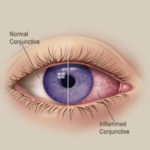0
My cartConjunctivitis is a condition in which the inner lining of the eyelid and the mucous membrane that covers the eyeball become inflamed. It can be infectious and has many different causes. Infectious conjunctivitis can be highly contagious and is common in children.
What causes Conjunctivitis?
What are the symptoms of Conjunctivitis?
In bacterial conjunctivitis, the eyes become swollen and red and are usually painful. There may be a sticky discharge from the eyes, which can vary from a moderate to a large amount. This discharge may cause the eyelids to become stuck together after sleep. The eyes may also be irritated and sensitive to light.
Viral conjunctivitis usually causes a watery discharge, unlike the sticky discharge caused by a bacterial infection. The eyes also become red and feel uncomfortable.
Allergic conjunctivitis is usually accompanied by other symptoms of allergy such as itchy eyes and excessive tear production. There may also be sneezing and an itchy or runny nose.


